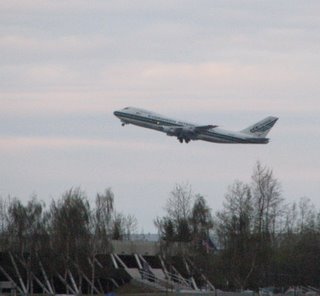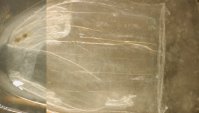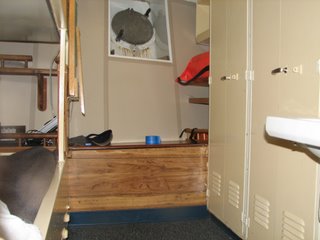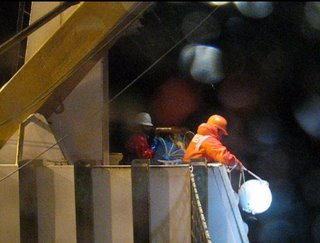Wednesday, May 30, 2007
Home Again

To my fellow TAS – Sorry, we were not near sea-ice this trip. We do have CTD data from the Gulf. I’m back in New York, but would be happy to connect you with the scientists in Seattle if you would like to get more information or possibly a sample.
Monday, May 28, 2007
Kodiak, Alaska
NOAA Ship MILLER FREEMAN
Mission: Fisheries Oceanography Coordinated Investigations
Day 10: May 28, 2007
Last night we stopped survey operations and sailed for the Coast Guard Station in Kodiak, Alaska. We went through a part of the island called Whale Pass. We saw whales blowing in the distance, sea otters drifting with the tide and a spectacular Alaska sunset that seemed to go on forever.
Today I had a day on Kodiak Island while I wait for my flight out tomorrow. What an amazing day. I tried to rent a car in the airport and was unsuccessful. I was sad at first, and then set out to make the best of it by exploring on foot. I started with some lunch. What a treat! For Memorial Day, Kodiak had something called a Crab Festival. There were rides, treats, and of course, Alaska King Crab. Take a look a lunch today!
I next set off on a long hike through the areas near the town of Kodiak. Lieutenant Sean had given me a list and guide to the town, and using that, I visited the harbors near town, and then a park just outside of town where I was able to hike through spruce trees covered with moss, and then find isolated beaches full of birds, including eagles.
Next, I decided to hike to the top of a mountain overlooking Kodiak, again, following Lieutenant Sean's recommendation. I found myself on top of a peak overlooking one of the most beautiful views I have seen on the trip so far. In fact, I took almost 500 photos today and had a very hard time selecting what to show you on the blog. I'll put more on the gallery when I get back to New York, so you can see more soon.
Sunday, May 27, 2007
Final Day of the Survey
Sea Wave Height: 2
Personal Log
We reach Kodiak in the morning. I am excited to be seeing Kodiak, but sad to be leaving the ship. It has been a wonderful 10 days at sea. Please check back tomorrow. I should be able to do a blog entry from the hotel in Kodiak and I can show you this incredible island. My heartfelt thanks to everyone on the ship who gave me such a wonderful welcome and who gave such support to this project.
Here are a few last photos from around the ship: Snuggy in the Captains chair and Snuggy at the wheel of the ship.
Science Log:
Today was an important part of the cruise. On section, in addition to the
We are coming to the end of the cruise now. We deployed the bongos 125 times and have done 8 CTD’s, and released one drifter buoy. The scientists had wanted to do more. They had planed 169 bongo deployments, but the bad weather forced us to change our plans. “That is the way things go out here,” says Chief Scientist Annette Dougherty. Lets talk to her more about what we have learned so far on this cruise:
Tell us what you have learned so far:
On the standardized grid we have been doing, the numbers of Pollock are low, but spread out across the grid. The fish are also small. 4.5 to 6.5 mm. Which is considerably smaller than last year.
What does that mean?
It is a colder year and a very turbulent year, with a lot of storms, and what that can do is flush things out through the strait we are sailing in. The fish may have spawned late. Or we could be catching the end of the hatching. It is hard to predict how many Pollock return as spawners if you can’t be out here all the time.
So what does the survey tell us?
This is a colder year, and the growth rate has been slow. They are eating, so it does not mean they will not survive. There is a lot of stuff out there.
The study mainly tells us about the early life history. About what the fish goes through from hatch to spawning. The egg is the strongest stage these fish have. After they hatch, they have a short time to use their yolk sack before they have to start to feed. If they can learn to feed! Some fish are stupid and they can’t figure that out and just die. Most figure it out because they have to grow. There is mortality around every corner for these fish. They flow with this current stream – well what if there is not food where it takes them? What if they don’t develop as fast as the fish up stream? They will be competing for the same food. There is a lot against these fish, and they manage to survive. Females produce thousands of eggs, but very few survive. There are a lot of hungry mouths out there!
What happens next in the study:
The database that we have been entering numbers into will go into a centralized database. I will also build a cruise report from that. It will state general numbers and what grid stations they occupied. The numbers that we put in are preliminary estimates of the population. We wait until the samples come back from Poland. They will be very meticulously sorted. Those final numbers are what we use for larval abundance (the number of Pollock babies).
How many years has this study been going on?
The study has been going on for 21 years now.
What have you learned in that time?
It is amazing how much things vary from year to year. It is hard to predict, based on a few environmental variables what will happen to these fish. You have to have patience. This could be a good recruitment year. We could have missed them.
When will you know for sure if it was a strong year?
We will have to wait for 3 to 4 years to decide how many will spawn. Next year in the March survey, we will be able to see how many we catch as one-year-olds. They go through their first year, which is very hard for them.
What is next for you?
I have a whole lot of odoliths (ear-bone samples) to read from another survey. I come back in September with Mat Wilson to see these same fish as what we call age-zero. They do a lot of growing between now and then. They don’t have a vertebra right now. They can’t swim against the current yet. At about 12 millimeters, they will begin to grow bones. That is the beginning of juvenal transformation. They will look like miniature adults in September. They are a beautiful golden bronze.
Saturday, May 26, 2007
A Tour of the Ship
Sea Wave Height: 1 Foot (Whew)
Personal Log
The sea finally calmed down. Calm seas are a great time to look for marine mammals, like whales and dolphins. In calm water, they are easier to spot. The picture above is a fin whale. Here is some video of a few Dall’s Porpoises that came by.
Ships like this are very different from our homes. First of all, everything is made of metal. So be careful. The walls are very hard. The ship has a lot crammed into a small space. So it may seem small in some ways, but there are lots of places to go and explore. The ship we are on actually has 5 decks. Would you like to take a trip around the ship? Click here for a walking tour. Tell me, is the ship larger than you thought? Smaller? Write me a comment and let me know.
Science Log:
We are continuing to wait for data from Excalibur. It may have flipped itself over during the storm a few days ago. Come on, Excalibur, let us know where you are!
In the mean time, the survey continues. We have deployed the bongo nets over 100 times so far on this cruise. Here is a photo of Chief Survey Technician Phillip White and I bringing in a bongo. Take a look at some of the creatures we are finding:

A jelly fish
An arrow chaedognath (brissle mouth) eating the larvae of a krill
Question of the Day:
How would you like to live on a ship? Write me and let me know what your thoughts are.
Answers to Your Questions:
The water temperature yesterday was 41.18 degrees Fahrenheit. The air temperature was 42.8.
Friday, May 25, 2007
The Survey Continues
Sea Wave Height 4 Feet:
Personal Log:
The low pressure system over our heads just will not let up. The seas are a little flatter today and I could sleep last night without feeling like I was going to wind up on the floor. In any ship, the sections at either end, the bow (front) or stern (back) move up and
 heavy seas. I’m way up in the bow. My cabin really moves. What does a cabin look like on a research ship? Well here is mine. Tomorrow we will take a tour of the entire ship.
heavy seas. I’m way up in the bow. My cabin really moves. What does a cabin look like on a research ship? Well here is mine. Tomorrow we will take a tour of the entire ship.I am also including some unique views of the ship while out at sea. As you can see from the photos, the weather just does not want change.
Science Log:
The work on the survey continues. The ship is moving in a kind of search pattern around the northern section of the Gulf of Alaska. We are looking for Pollock larvae and we are finding many. We are also finding lots of other cool creatures in our nets. Here are a few:
We are still waiting to hear more data from Excalibur, though it has returned some. Keep watching the drifter site for more information. In the mean time, here are some intersting creatures from today's catch. You can double click the photos to make them larger.
This segmented worm usually stays near the bottom. When it is ready to lay eggs, it swims up into the water and scatters its eggs in the water as it goes. We must have caught this one as it moved up off the bottom to lay eggs. Can you see the eggs in the photos?
These are crab zoea. They will become like the crabs we think of later in their lives. The long spines may prevent preditors from eating them.
A smiling face!
This little copepod hasn't been eating crabbie paddies! You can see its dinner both before and after it has been eaten in this photo.
The shell fish here are called thecosomate pteropods. Theco means shell and somate means body. ptero means wing and pod means foot. So they look like shelled winged feet when they move. They eat phytoplankton (tiny plants).
The long white creatures are larvaceans. They move their tails to make a current that moves food into their bodies. Look how many different kinds of creatures there are in these samples we are bringing up!
Answers to your Questions
The ship was pointed at 51 degrees and moving at 355 degrees because the wind was blowing against the side of the ship.
Yes, Morgan, we do experiments 24 hours a day, 7 days a week. Work continues today as always. Toby, I’ll be back next week.
Marty. Great to hear from you. I will say hello to all. Thanks for the great information.
Hello to Mrs. Bolte’s Class, Amanda and Ms. Stern’s Class. Great to hear from you all.
Mrs. Freeley’s Class, we catch only baby fish, but have seen many other kinds besides Pollock. The scientists, however, are mainly interested in Pollock. We eat lots of different kinds of fish. Last night, we had halibut. Tonight, we are having shrimp. And I’m hungry.
We do take showers, but you have to hang on when the ship moves or you wind up leaving the shower a little before you planed on it.
How do we sleep? In a “rack,” which is ship-talk for a bed. It is kind of fun in high seas to lay flat on your rack and look at your feet going way up above your head as the ship rolls over the waves. It takes a little getting used to. There is a picture of my cabin on the blog today for you. There are no animals on the ship this year.
Thanks to all for writing.
Thursday, May 24, 2007
What Are We Seeing??
Sea Wave Height: 6 Feet
Science Log
Last night around 2:00 AM Alaska Time, we reached the point in the cruise where we were in the right position to deploy our drifter buoy. We stood on the back deck and gently lowered it over the side of the ship and watched it disappear into the Alaska night. Bon Voyage, Excalibur! Click here for the video. We heard from the buoy several times overnight and now are having trouble reaching the website. I will download data as soon as I can.
It was wonderful to see Excalibur in the water. I’m proud of each and every student in Mrs. O’Brien’s Class who worked so hard to put this buoy together. I can’t wait to get back and see the data from the buoy with you.
Another gale has blown in and we are again facing winds above 30 kts. And heavy seas. The work has been tough but we have been able to continue. Well, you have seen how the nets work, you have seen how the lab works. Today I would like to show you some of the incredible creatures that have come up in our tiny nets. The little bowl of reddish liquid you see here holds an incredible array of creatures which make up the plankton community in the Gulf of Alaska. Lets meet a few. We will need a microscope to do it. All of the pictures you see here were taken with a camera mounted to a microscope. But first, will the real Sheldon Plankton from Sponge Bob, please stand up…
This is a baby crab. The female carries the eggs. When they hatch, the float around for a few weeks eating phytoplankton. They go through 3 major stages. This is the last one. At this stage, the crab settles to the bottom and starts to begin life as a bottom dweller. At each stage, these creatures shed a shell, swell with water, form a new shell and then expel the water they absorbed before they grew the new shell. They use the extra space to for real grow before they have to shed again.
This is a pollock larvae. That may be the yolk sack from the egg under its mouth! It absorbs the yolk and then must begin to look for food on its own. You are seeing this pollocks first real meal.
This is what shrimp look like, when they first hatch. Shrimp like this look red to us, but in deeper water, where there is less sunlight, the red looks black, not red. What great camouflage!
Another pollock larvae. You can clearly see the eye and mouth. This pollock does not have a yolk sack, so it has been eating on its own. Do you see the food in its stomach? I wonder what it has been eating. Take a guess and write a comment. There are no real fins at all on this fish, yet. See how small the stomach is? These fish have to find food and find it fast. They cannot store energy in their bodies yet.
Several different types of zooplankton gather around some phytoplankton. Here is the beginning of the food web. The algae in this photo serve as food for many little creatures in the sea. The copepods and other small creatures eat the tiny phytoplankton, and in turn are eaten by small fish.
This is a a creature called a hyperiid amphipod. It is related to a sand flea. They live in plankton. These particular ones will borrow into the surface of jellyfish and ride around on them. They are tiny hitchhikers. They have plates on their abdomen are where the babies stay when they are young.
The storm is really raging now and the seas are getting bigger. I am NOT seasick! That is because of Lt. Sean. He gave me some medicine which seems to be working. Now it is kind of fun to be out her since the waves don’t’ bother me any more. I kind of enjoy the ride now. We are REALLY moving up and down.
Question of the Day
This is a complex one, but an important concept if you ever sail. The ship was facing 51 degrees (North East) when we let off the buoy, but the ship was moving 355 degrees (almost true north). Why would the ship face one way and travel a slightly different way?
HINT: Think about how the storm affects the ship
Answers to your Questions
The answer to yesterday’s question was 12.5 x 24 or 300 kts. or about 345 miles. Congratulations all who got this one correct. Of course, we stop a lot here to take measurements, so we do not go that far in a day.
Many of you asked how much we are finding. I’ll tell you about that in a day or so when the scientists have a better idea of what the data is showing.
We have not seen any sharks. That’s OK with me.
Was it scary to be at sea in a storm? Not really. You get used to the waves after a while. They are really rolling along right now. But people here are used to it and go about their lives as people do.
What was the deepest ocean we have sailed over so far? 240 meters. We will sail over deeper water in the days to come.
Josh, I’m not getting sea-sick anymore, and there are not many people on deck right now because of the storm. Most of us are inside unless we have to work.
Amanda, good question. I don’t really feel the tides, but I know they are there. They just move us around a little, but what I really feel are the waves from the storm.
Hello as well to Lt. Sean’s family. Thanks so much for writing. I’m glad you are enjoying the blog.
Hello to Nazilla and Earnest in Seattle. Thanks for writing.
Excalibur has Been Deployed!!










